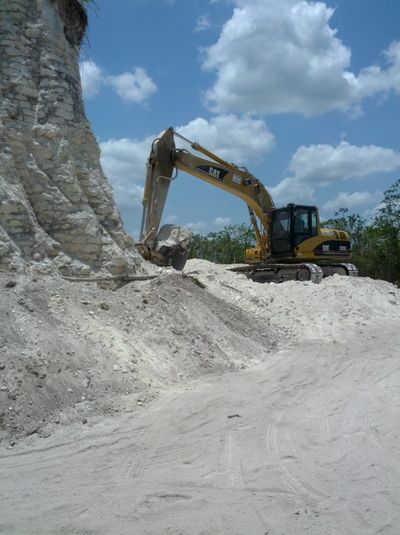Builders bulldoze Mayan pyramid
Company took rocks for road project

BELIZE CITY – A construction company has essentially destroyed one of Belize’s largest Mayan pyramids with backhoes and bulldozers to extract crushed rock for a road-building project, authorities announced Monday.
The head of the Belize Institute of Archaeology, Jaime Awe, said the destruction at the Nohmul complex in northern Belize was detected late last week. The ceremonial center dates back at least 2,300 years and is the most important site in northern Belize, near the border with Mexico.
“It’s a feeling of incredible disbelief because of the ignorance and the insensitivity … they were using this for road fill,” Awe said. “It’s like being punched in the stomach, it’s just so horrendous.”
Nohmul sat in the middle of a privately owned sugar cane field and lacked the even stone sides frequently seen in reconstructed or better-preserved pyramids. But Awe said the builders could not possibly have mistaken the pyramid mound, which is about 100 feet tall, for a natural hill because the ruins were well-known and the landscape there is naturally flat.
“These guys knew that this was an ancient structure. It’s just bloody laziness,” Awe said.
Photos showed backhoes clawing away at the pyramid’s sloping sides, leaving an isolated core of limestone cobbles at the center, with what appears to be a narrow Mayan chamber dangling above one clawed-out section.
Belizean police said they are conducting an investigation and criminal charges are possible. The Nohmul complex sits on private land, but Belizean law says that any pre-Hispanic ruins are under government protection.
The Belize community-action group Citizens Organized for Liberty Through Action called the destruction of the archaeological site “an obscene example of disrespect for the environment and history.”
It is not the first time it’s happened in Belize, a country of about 350,000 people that is largely covered in jungle and dotted with hundreds of Mayan ruin sites, though few as large as Nohmul.
Norman Hammond, an emeritus professor of archaeology at Boston University who worked in Belizean research projects in the 1980s, wrote in an email that “bulldozing Maya mounds for road fill is an endemic problem in Belize … but this sounds like the biggest yet.”
Arlen Chase, chairman of the Department of Anthropology at the University of Central Florida, said, “Archaeologists are disturbed when such things occur, but there is only a very limited infrastructure in Belize that can be applied to cultural heritage management.”
He said there had probably still been much to learn from the site. “A great deal of archaeology was undertaken at Nohmul in the ’70s and ’80s, but this only sampled a small part of this large center,” he said.